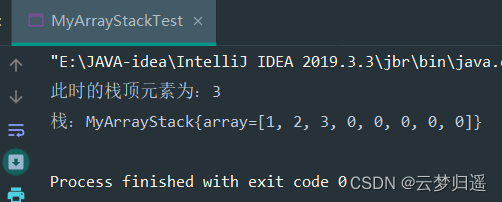热门标签
热门文章
- 1Git上传代码文件到仓库_git上传代码到仓库
- 2基于Java校园失物招领系统小程序设计和实现(源码+LW+部署讲解)_基于java的校园失物招领平台的设计与实现
- 3滤波器设计之巴特沃斯滤波器_巴特沃斯滤波器公式
- 4这种银行病毒是2022年12月的头号恶意软件_2022年银行黑客攻击
- 55. C++第一节到第四节总结_c++符号表
- 6JSON---JavaScript对象表示法_javascript json
- 7github action自动部署构建入门_github自动构建
- 8微信小程序 之 网络请求、数据解析、页面渲染、动态参数_小程序发送请求接口,解析响应数据
- 9从加密到签名:如何使用Java实现高效、安全的RSA加解密算法?_java rsa加密
- 10Oracle 函数_oracle 调用函数
当前位置: article > 正文
线性表 - 栈(数组和链表两种方式实现栈)_栈用链表还是数组存贮
作者:知新_RL | 2024-05-17 03:25:36
赞
踩
栈用链表还是数组存贮
线性表 - 栈(数组和链表两种方式实现栈)
1.1 栈的介绍
-
栈和队列都属于线性数据的逻辑存储结构
-
栈(stack)是一种线性数据结构,栈中的元素只能先入后出(First In Last Out,简称FILO)
-
最早进入的元素存放的位置叫作栈底(bottom),最后进入的元素存放的位置叫作栈顶(top)
-
存储原理

-
栈既可以用数组来实现,也可以用链表来实现
-
栈的数组实现如下:
- 数组实现的栈也叫顺序栈或静态栈,链表实现的栈也叫做链式栈或动态栈
- 栈的链表实现如下:

-
-
操作
-
入栈(压栈)
- 入栈操作(push)就是把新元素放入栈中,只允许从栈顶一侧放入元素,新元素的位置将会成为新的栈顶


- 入栈操作(push)就是把新元素放入栈中,只允许从栈顶一侧放入元素,新元素的位置将会成为新的栈顶
-
出栈(弹栈)
- 出栈操作(pop)就是把元素从栈中弹出,只有栈顶元素才允许出栈,出栈元素的前一个元素将会成为新的栈顶


- 出栈操作(pop)就是把元素从栈中弹出,只有栈顶元素才允许出栈,出栈元素的前一个元素将会成为新的栈顶
-
1.2 数组实现栈(顺序栈 / 静态栈)
package com.lagou.entity; import java.util.Arrays; /** * @author 云梦归遥 * @date 2022/5/12 17:18 * @description */ public class MyArrayStack { private int[] array; //构建的数组对象 private static final int ARRAY_LENGTH = 8; // 定义无参构造默认的数组长度 private int length = 0; // 记录数组有效长度 // 数组构造方法 public MyArrayStack(){// 默认构造方法数组长度为 8 this.array = new int[ARRAY_LENGTH]; } public MyArrayStack(int len){// 有参构造则依靠传入的整型数字来构造数组 this.array = new int[len]; } // 入栈 public void push(int num){ array[length++] = num; } // 出栈 public int pop(){ return array[length--]; } // 获取栈顶元素,但不删除栈顶元素 public int top(){ return array[length]; } @Override public String toString() { return "MyArrayStack{" + "array=" + Arrays.toString(array) + '}'; } }
- 1
- 2
- 3
- 4
- 5
- 6
- 7
- 8
- 9
- 10
- 11
- 12
- 13
- 14
- 15
- 16
- 17
- 18
- 19
- 20
- 21
- 22
- 23
- 24
- 25
- 26
- 27
- 28
- 29
- 30
- 31
- 32
- 33
- 34
- 35
- 36
- 37
- 38
- 39
- 40
- 41
- 42
- 43
- 44
进行测试
package com.lagou.test; import com.lagou.entity.MyArrayStack; /** * @author 云梦归遥 * @date 2022/5/12 17:22 * @description */ public class MyArrayStackTest { public static void main(String[] args) { MyArrayStack stack = new MyArrayStack(); stack.push(1); stack.push(2); stack.push(3); stack.pop(); int top = stack.top(); System.out.println("此时的栈顶元素为:" + top); System.out.println("栈:" + stack); } }
- 1
- 2
- 3
- 4
- 5
- 6
- 7
- 8
- 9
- 10
- 11
- 12
- 13
- 14
- 15
- 16
- 17
- 18
- 19
- 20
- 21

1.3 链表实现栈(链栈 / 动态栈)
package com.lagou.entity; /** * @author 云梦归遥 * @date 2022/5/12 17:25 * @description */ public class MyLinkStack { public class MyLink{ private int value; private MyLink link; public MyLink(){ this.value = 0; this.link = null; } public MyLink(int value){ this.value = value; this.link = null; } public MyLink(int value, MyLink link){ this.value = value; this.link = link; } @Override public String toString() { return "MyLink{" + "value=" + value + ", link=" + link + '}'; } } private MyLink head = new MyLink(0, null); // 头结点 public void push(int num){ MyLink node = new MyLink(num); MyLink temp = head.link; // 创建临时节点吗,进行节点的遍历 if (head.link == null){ head.link = node; } else { while (true){ if (temp.link == null){ break; } else { temp = temp.link; } } temp.link = node; } head.value++; // 链表长度 + 1 } // 出栈 public int pop(){ if (head.value == 0){ return 0; } else { MyLink temp = head; for (int i = 1; i < head.value; i++){ temp = temp.link; } MyLink popNode = temp.link; temp.link = null; head.value--; return popNode.value; } } // 只返回栈顶元素,而不让元素出栈 public int top(){ if (head.value == 0){ return 0; } else { MyLink temp = head; for (int i = 1; i < head.value; i++){ temp = temp.link; } return temp.link.value; } } // 获取整个栈 public String select(){ StringBuilder stringBuilder = new StringBuilder(); if (head.value == 0){ return "null"; } else { stringBuilder.append("【栈中元素个数:" + head.value + "】"); MyLink temp = head; for (int i = 1; i < head.value; i++){ temp = temp.link; stringBuilder.append(temp.value + " => "); } stringBuilder.append(temp.link.value); return stringBuilder.toString(); } } }
- 1
- 2
- 3
- 4
- 5
- 6
- 7
- 8
- 9
- 10
- 11
- 12
- 13
- 14
- 15
- 16
- 17
- 18
- 19
- 20
- 21
- 22
- 23
- 24
- 25
- 26
- 27
- 28
- 29
- 30
- 31
- 32
- 33
- 34
- 35
- 36
- 37
- 38
- 39
- 40
- 41
- 42
- 43
- 44
- 45
- 46
- 47
- 48
- 49
- 50
- 51
- 52
- 53
- 54
- 55
- 56
- 57
- 58
- 59
- 60
- 61
- 62
- 63
- 64
- 65
- 66
- 67
- 68
- 69
- 70
- 71
- 72
- 73
- 74
- 75
- 76
- 77
- 78
- 79
- 80
- 81
- 82
- 83
- 84
- 85
- 86
- 87
- 88
- 89
- 90
- 91
- 92
- 93
- 94
- 95
- 96
- 97
- 98
- 99
- 100
进行测试
package com.lagou.test; import com.lagou.entity.MyLinkStack; /** * @author 云梦归遥 * @date 2022/5/12 17:40 * @description */ public class MyLinkStackTest { public static void main(String[] args) { MyLinkStack myLinkStack = new MyLinkStack(); myLinkStack.push(1); myLinkStack.push(2); myLinkStack.push(3); System.out.println("当前整个栈:" + myLinkStack.select()); myLinkStack.pop(); int num = myLinkStack.top(); System.out.println("当前栈顶元素为:" + num); System.out.println("当前整个栈:" + myLinkStack.select()); } }
- 1
- 2
- 3
- 4
- 5
- 6
- 7
- 8
- 9
- 10
- 11
- 12
- 13
- 14
- 15
- 16
- 17
- 18
- 19
- 20
- 21
- 22

1.4 栈的总结
-
时间复杂度
- 入栈和出栈的时间复杂度都是O(1)
- 支持动态扩容的顺序栈
- 当数组空间不够时,我们就重新申请一块更大的内存,将原来数组中数据统统拷贝过去。这样就实现了
- 一个支持动态扩容的数组,通过前面学过的知识,可以得知入栈的时间复杂度是O(n)
-
应用
- 函数调用
- 每进入一个函数,就会将临时变量作为一个栈入栈,当被调用函数执行完成,返回之后,将这个函数对应的栈帧出栈
- 浏览器的后退功能
- 我们使用两个栈,X 和 Y,我们把首次浏览的页面依次压入栈 X,当点击后退按钮时,再依次从栈X 中出栈,并将出栈的数据依次放入栈 Y。当我们点击前进按钮时,我们依次从栈 Y 中取出数据,放入栈 X 中。当栈 X 中没有数据时,那就说明没有页面可以继续后退浏览了。当栈 Y 中没有数据,那就说明没有页面可以点击前进按钮浏览了
- 函数调用
声明:本文内容由网友自发贡献,不代表【wpsshop博客】立场,版权归原作者所有,本站不承担相应法律责任。如您发现有侵权的内容,请联系我们。转载请注明出处:https://www.wpsshop.cn/w/知新_RL/article/detail/581735
推荐阅读
相关标签



